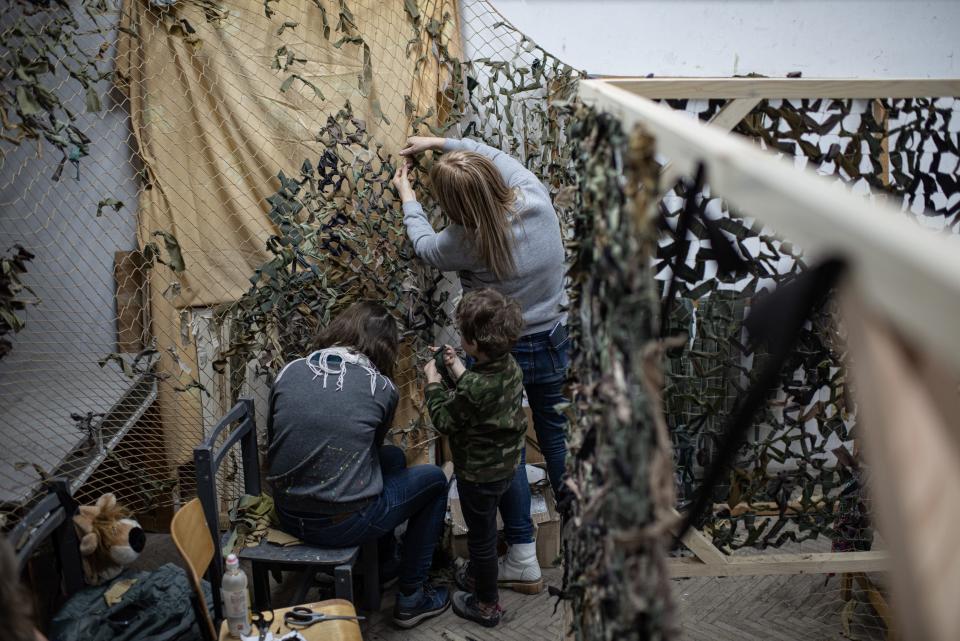Why a 'quagmire' might be the most realistic goal of new US surge in military aid to Ukraine
WASHINGTON – With Russia’s war in Ukraine at a stalemate, Ukrainian President Volodymyr Zelenskyy received an outpouring of support in Washington after his direct and emotional plea in a speech to Congress for help.
"We need you right now," Zelenskyy said, invoking Pearl Harbor and the Sept. 11 attacks on the USA to argue for military supplies that he said could help save Ukrainians.
The flow of more weapons to Ukraine could ramp up pressure on Moscow to come to the negotiating table, though military experts don’t expect a breakthrough, either on the battlefield or in talks, in the near term.
A “quagmire is the realistic ‘goal,’” said Michael O’Hanlon, a senior fellow at the Brookings Institution, though helping Ukraine fight the Russians and weakening Russia's economy with crippling economic sanctions could set the stage for successful peace talks.
As weapons and other supplies flow into Ukraine, the military stalemate will harden, said Mark Cancian, senior adviser with the Center for Strategic and International Studies International Security Program.
“That may be the point when Russia decides that it's worth negotiating,” he said. “They seem to be edging towards that now anyway.”
Russian and Ukrainian officials have talked about a potential peace plan, but Russian President Vladimir Putin declared last week that his invasion was going according to plan and that Russia would not retreat.
'Is this too much to ask?' An impassioned Zelenskyy demands more from Biden
Reduced to rubble: Heartbreaking images explore Ukraine's devastated residential areas

At least 847 civilians, including 64 children, have been killed since Russia invaded Ukraine on Feb. 24, the U.N. Human Rights Office of the High Commissioner reported Saturday, but the agency said the actual figures are much higher. Agents also estimated the violence had left nearly 1,400 civilians injured, including 78 children. The Ukraine government estimates that 2,300 people have died in the ongoing siege of Mariupol alone.
Estimates of Russian deaths also vary widely. The Ukraine government puts the Russian death toll at more than 14,000. Even conservative figures are in the low thousands – a much faster pace than in previous Russian offensives, threatening support for the war among ordinary Russians.
Raising the costs for Russia
President Joe Biden announced $800 million more in military aid hours after Zelenskyy's speech to Congress on Wednesday. He said the goal was to weaken Putin’s position while strengthening the Ukrainians' hand militarily and diplomatically. .
“More will be coming,” Biden promised as he warned that “this could be a long and difficult battle.”
Lauren Kahn, a defense innovation expert at the Council on Foreign Relations, agreed that “we're in for a long haul here.”
The additional assistance will buy Ukraine more time, though it remains to be seen, she said, whether Russia can regroup from an invasion it thought would take three days and is now in its fourth week.
“It's a matter of, can we raise the cost enough of their invasion in order to make them either stall it or give Ukraine a chance to exploit Russian errors further,” Kahn said. “But again, if Russia's military performance improves, rather than continues to be as poor as it has been so far, I'm a little skeptical of this doing much to help with that.”
Spirited, creative resistance from Ukrainians and shoddy, hesitant performance from the Russian military have stalled Russia's advance so far, according U.S. and British defense officials.
Russia’s invading troops are struggling with Ukrainian terrain, forcing them to remain on roads where Ukrainian forces have slowed their progress, according to a British Defense Ministry assessment.
The Russians have been reluctant to drive off-road in Ukraine, and Ukrainians have further halted their progress by blowing up bridges, British defense attache Mick Smeath said in a statement Wednesday morning.
'Stalemate is not armistice or cease-fire'
Russian warplanes have failed to gain control of Ukrainian airspace, according to the British and U.S. military, further limiting the invaders’ ability to protect their ground forces.
A report from the Institute for the Study of War concluded that Ukrainian forces have defeated the initial Russian campaign of the war, but the report also highlighted activity of Russian forces, which have shown signs of "digging in around the periphery of Kyiv and elsewhere."
"Stalemate is not armistice or cease-fire. It is a condition in war in which each side conducts offensive operations that do not fundamentally alter the situation. Those operations can be very damaging and cause enormous casualties," Frederick W. Kagan, George Barros and Kateryna Stepanenko wrote in an assessment published Saturday.
'Why? Why? Why?': Ukraine's Mariupol descends into despair
More: Putin war crimes in Ukraine will be investigated, but Russian leaders unlikely to be prosecuted
More US weapons in lieu of no-fly zone
In his address to Congress, Zelenskyy renewed his appeal for the U.S. to enforce a no-fly zone over Ukraine. The Biden administration has ruled that out to avoid direct engagement with Russian pilots that could escalate the fight with a nuclear-armed foe.
Another reason, a U.S. defense official, who was not authorized to speak publicly about intelligence findings, said this week, is that a no-fly zone wouldn’t necessarily prevent Russian airstrikes on Ukraine. The official noted that Russia launched a deadly cruise-missile attack on a base in western Ukraine on Sunday with bombers that never left Russian airspace.
New Jersey Rep. Tom Malinowski, a Democrat who serves on the House Foreign Affairs committee, said Zelenskyy’s repeated requests for a no-fly zone – when that’s already been rejected – are likely an attempt to make the U.S. feel guilty “so that we work even harder on everything that we can do.”
“It’s brilliant,” Malinowski said. “It's exactly what he should be doing. It's effective.”
Several weapon systems beyond the Javelin anti-armor and Stinger anti-aircraft missiles are under consideration to support Ukrainian forces, according to a congressional source who spoke about discussions on weapons systems on condition of anonymity. They include armed drones as well as Russian-made S-300 and S-800 anti-aircraft systems.
Sen. Richard Blumenthal, D-Conn., and a member of the Armed Services Committee, said ending Russia’s “reign of terror from the sky” requires the U.S. to supply more sophisticated anti-aircraft missiles than the shoulder-fired Stinger now being supplied. He called for drones as well as more Stingers and Javelin anti-tank weapons.
“They need more robust, more numerous means of defending against attacks on maternity wards,” Blumenthal said, citing a Russian attack last week.
Transcript: Ukrainian President Volodymyr Zelenskyy addresses Congress
More: Zelenskyy asked U.S. Congress to create a no-fly zone over Ukraine. What does that mean?

What weapons does Ukraine need?
To continue to inflict losses on the Russians, Ukrainian forces need anti-tank weapons that are lighter than the 50-pound Javelins supplied by the U.S. military, and anti-aircraft missiles with more range than the American Stinger, said Loren Thompson, a military analyst at the Lexington Institute and a defense industry consultant.
Ukrainian forces need weapons to ambush Russians, attack quickly and retreat to avoid their advantages in firepower, Thompson said.
“Patriot missiles, F-35s and Abrams tanks are great if you want to prevent a country from invading,” Thompson said, referring to sophisticated American weapons. “The Ukrainians need lightweight weapons with reach and precision to take out Russian tanks and aircraft.”
The Ukrainian military has the ability to use more lethal weapons, the congressional source said, noting that the Ukrainians shot down the majority of the 30 missiles fired at the Yavoriv military training base in western Ukraine.

Senate Minority Leader Mitch McConnell, R-Ky., agreed that there are other ways “to make the air dangerous for the Russians” besides a no-fly zone. But he accused Biden of not doing enough to help Ukraine, saying the president “needs to step up his game, right now, before it’s too late.”
Kahn, the research fellow at the Council on Foreign Relations, said the administration is right to be cautious about taking steps that could escalate the war. The $800 million in additional aid Biden announced Wednesday is a natural next step, she said, “and I think we’ll see where it goes from there.”
Militaries go through enormous amounts of equipment and munitions in the kind of intense combat the Ukrainians are in, said Cancian at the Center for Strategic and International Studies.
“Providing this equipment, the continual provision,” he said, “means that time will be on the Ukrainian side.”
Helping Ukraine hold the line while sanctions eat away at Russia’s strength, Malinowski said, “can get you to a point where the Ukrainians have the upper hand in any negotiations and the war.”
A 'cold-blooded' alliance?: China could be a pivotal force in Russia's war against Ukraine
Contributing: John Bacon, USA TODAY, and The Associated Press
This article originally appeared on USA TODAY: Could a US military aid surge to Ukraine squeeze Putin in peace talks?


